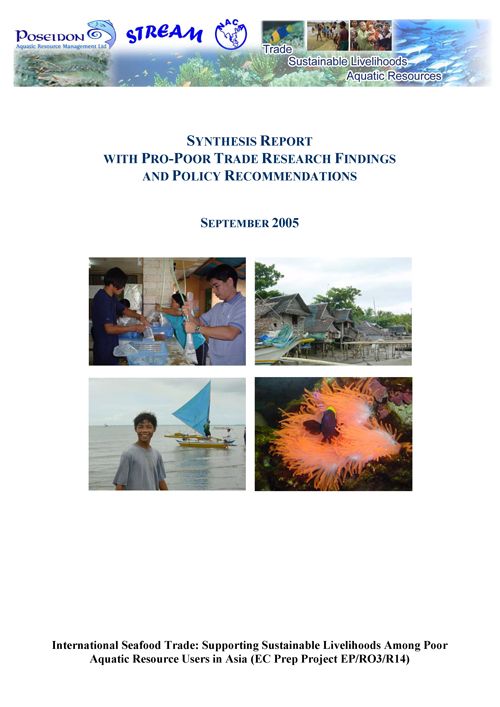International seafood trade: Supporting sustainable livelihoods among poor aquatic resource users in Asia. Synthesis report with pro-poor trade research findings and policy recommendations
30 November 2005 | Macfadyen, G., Banks, R., Phillips, M. and Haylor, G. | 1933 Downloads | .pdf | 605.71 KB | Gender, Livelihoods, gender and social issues, Marine finfish, Ornamentals, Shrimp
The global export value of fisheries products has grown significantly in recent years in response to consumption trends, and is currently around € 60 billion a year. Developing countries are increasingly important suppliers of fisheries products, with the EU a major importer, consuming 63% of internationally traded seafood. This trade has significant implications for the livelihoods of poor people in Asia, where fisheries and fisheries products provide food and income for some of the poorest and most marginalised people in the region.
The European Community's Poverty Reduction Effectiveness Programme (EC-PREP) is a programme of research to enhance collaboration between the European Commission and the UK Department for International Development (DFID). Its main objective is to enhance the poverty impact of the European Community’s development assistance and contribute to achieving the International Development Target of halving the number of people living in extreme poverty by 2015.
This report has been prepared by Poseidon Aquatic Resource Management Ltd / Network of Aquaculture Centres in Asia-Pacific (NACA), and represents Output 3 of an EC-PREP Project (EP/R03/014) funded by DFID and entitled “The International Seafood Trade: supporting sustainable livelihoods among poor aquatic resource users in Asia”. The project focused specifically on exports to the EU of shrimp from Vietnam (especially to the UK, and BeNeLux countries), and of marine ornamental species from Philippines and Indonesia (especially to the UK and France), and possible pro-poor trade mechanisms related to this trade.
The purpose of the project was to investigate international trade in fisheries products and its relationship to poverty alleviation and livelihoods of poor aquatic resource users in developing countries in Asia, and to identify options to improve the effectiveness of poverty reduction through international seafood trade. The project directly addressed the EC-PREP priority area of trade and development, and indirectly provided valuable insight to two other priority areas: food security and sustainable rural development; and institutional capacity building.
This synthesis report (Output 3) follows other reports produced by the project.
Output 1 is a background overview based on a literature review and interviews with supply chains in the EU. The overview included: (i) a description of seafood market supply chains and trade volumes; (ii) the policy and institutional contexts relating to trade and poverty reduction, at global, regional and national levels, and their implications for poverty reduction; (iii) ongoing trade initiatives aimed at poverty reduction; and (iv) some initial ideas about pro-poor trade initiatives to be explored by the project.
Output 2 reports the findings of field-based case studies in Vietnam, Indonesia and the Philippines conducted over the course of 2004 which (i) mapped the market chain and identified stakeholders; (ii) identified poor stakeholders and analysed their livelihoods; (iii) provided understanding of the influence of trade on the livelihoods of poor people in the market chain; and (iv) identified pro-poor options for trade in aquatic animals and plants.
Output 3 provides a synthesis report and combines the key findings of the overview report and the field-based investigations, to draw together key research findings and policy recommendations.
Creative Commons Attribution.

